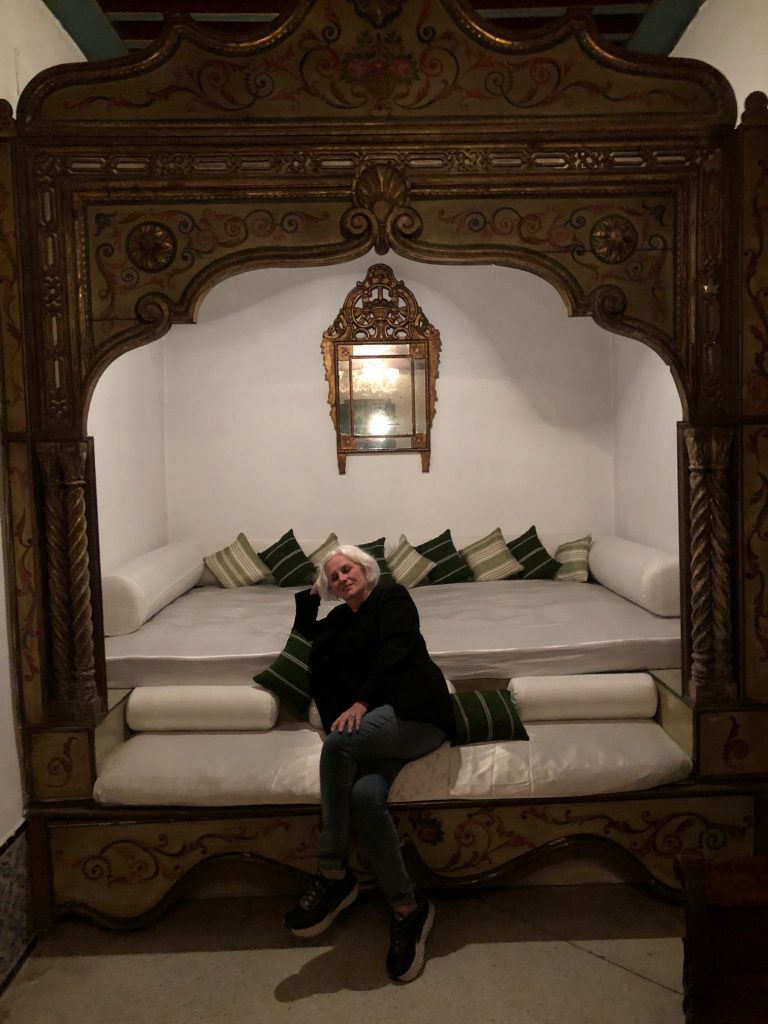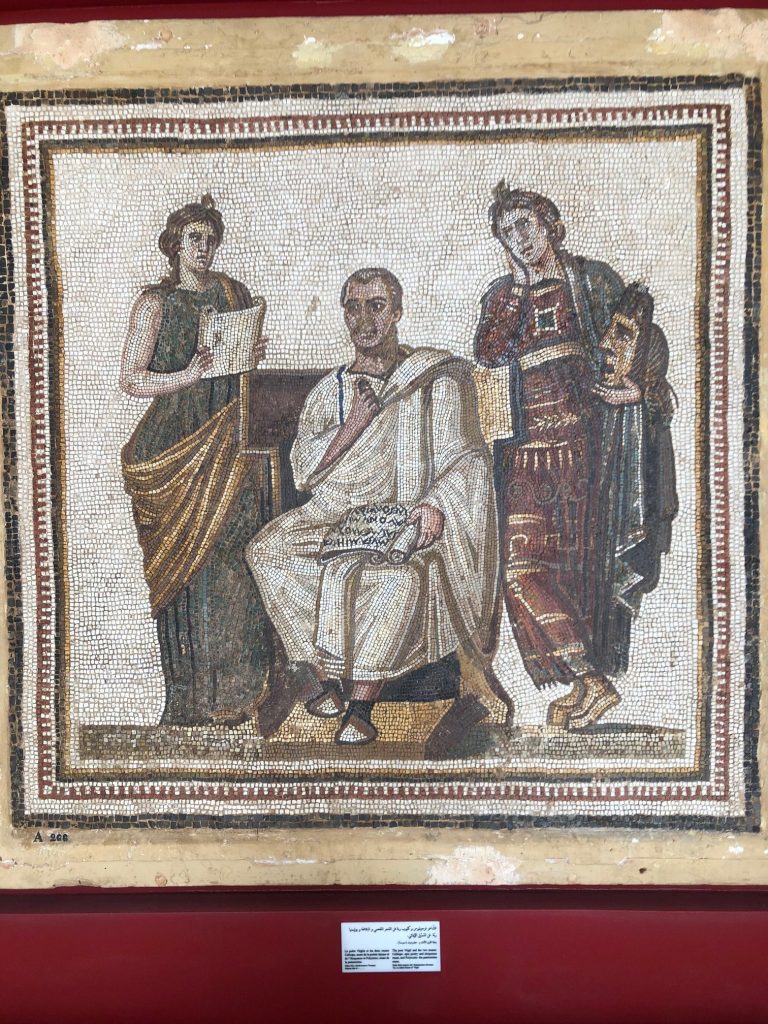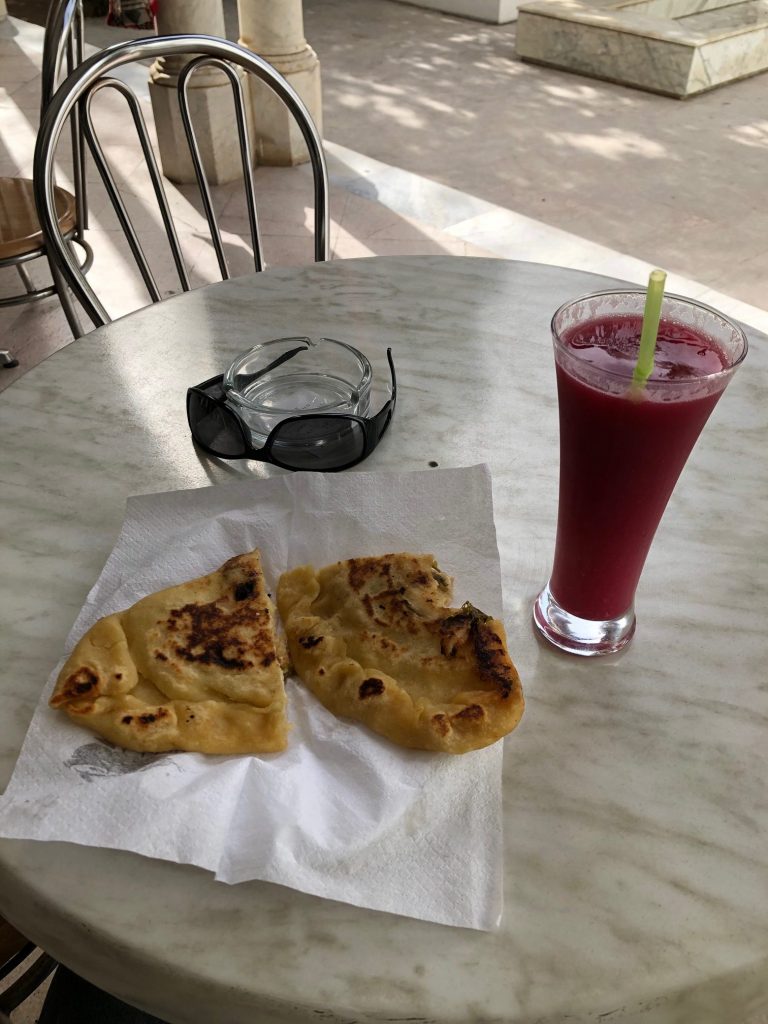I spent two nights and one whole day in Tunis, the capital, at the Dar El Jeld hotel, a gracious old palace in the heart of the medina (old city). You entered by way of one of these stout traditional doors straight off the laneway. All the buildings in the medinas of the Maghreb* have such an entrance because according to those Islamic cultures, there should be no display of wealth and the passerby should not be able to tell whether a prince or a pauper lives within.

In the case of the Dar el Jeld I’d say it was definitely a prince. The alcove below gives you an idea of what it was like, and how creatively and gorgeously it’s been adapted for modern travellers. I had a huge spacious apartment all to myself, with my own living room with comfy chairs, a table set for two with linen napkins and proper cutlery to attack the array of free dates and bickies and chocolates (I thought cutlery for dates was a bit over the top), a double wardrobe with plenty of free range hangers (not those annoying things that attach to a hook on the rack and which scream ‘we don’t trust you!’) and a double bathroom which allowed me to spread all my stuff around willy-nilly and with space left over. For the first time I felt as though I really should be sharing with some nice gentleman friend. Or lady friend if she didn’t mind sharing the king-size bed, and as long as neither of them snored or minded my snoring, since I’ve picked up a minor head cold/chest infection somewhere along the way.

There was a mini-bar too with snacks and grog of all kinds, but the prices were a bit scary and I still had most of my stash of vino ordinario from Rome, decanted into plastic water bottles to lighten the load.
There was only one little design imperfection in all this Arabesque loveliness. There were 5 floors, the restaurant being on the fifth, but the numbers of the floors did not correspond to the numbers of the rooms. I was on the 4th floor, as were all the rooms starting with 2, like mine. Some of the lifts only went to the second floor and …. long story short I pressed the button for the floor I was already on. This caused the lift to stay still, then the light to go off, trapping me inside in the pitch dark. I hammered on the door and screamed for help. Nobody heard and nobody came. I thought there must have been a power failure. Eventually I tried mightily to prise the doors apart, at which point the lights came back on and I thought: the power’s come back on – hallelujah! The doors opened – coincidence? I still don’t know – and I then pressed the button for the ground floor, which was still the wrong button, since the reception and entrance were on the 1st floor, a fact I only realised on the morning of my departure after twice taking the steps up from the ground floor to the reception area, itself a bit of a maze. No doubt it was designed that way in the past to thwart intruders. I made a feeble effort to report this misadventure to the girls at reception, but either my schoolgirl french wasn’t up to it – for they looked at me blankly when I tried out various permutations of ‘l’ascenseur s’est arrete avec moi dedans! Est-ce que le pouvoir a ete interrompu? – or they just hoped I would stop talking and go away. In any case I only did it once more, hammering and yelling for help, similarly unheeded, before I put deux et deux together and pressed a different button.

This was the divan of the aforesaid prince or emir or poobah or whatever. I remember divans were a Thing in my childhood – a sort of long padded stool with no armrests or backrest, a briefly fashionable item of 60s modernism. Here they refer not just to the particular piece of furniture but to the chamber containing it. I can’t hear the word ‘divan’ these days without thinking of Ca Plane Pour Moi – that 1977 one-hit-wonder by Plastique Bertrand full of obscure French slang in which he shouts that he is the king of the divan. (Google it and you’ll see there’s no reliable translation, even of the title!)
I mention it by way of explaining and asking you to pardon my French. Tunisia was a French colony until 1956 and the country has only just thrown off dictatorship. Remember the Jasmine Revolution of 2011, the first of the so-called Arab Spring? They’ve had setbacks on the road to democracy and liberalism since then – more on that in a while – but for the present tourism is still in its infancy and most visitors come from France and Italy. Hence French being the lingua franca for locals and visitors. People tend to address me in French so I try to respond likewise rather than wimping out to English, at which they’re not as good.
[For example, the following incident happened at my Morocco hotel at brekkie this morning: I was chatting to a solo-traveling American chap, getting right back into an Anglo mindset. This caused me to also address the young waiter in English, giving him to understand apparently that I didn’t want any food yet (I did) but would look forward to the fish dish I thought he said was on the menu (he didn’t). A second consultation brought me a cup of strong black coffee and no food. A third brought me juice and fruit salad – getting there – and a cup of hot chocolate. A fourth consultation brought me pancakes (unordered but welcome) and hot cafe latte – parfait! – and there was no sign of fish. And if you’re thinking of course there wouldn’t be fish for breakfast, you’re wrong. There was often fish in the hot buffets. AND in Morocco, vegetable soup! Moral of the story: should have stuck to my imperfect French. Never had any problems getting food or drink yesterday or in Tunisia.]

But back to Tunisia and the first thing to do was to get some cashish. The hotel sent a man to escort me to the nearest ATM. That’s him above, one of numerous immaculately-besuited gentlemen at the beck and call of guests at the Dar El Jeld, or more precisely of the manager who had but to snap his fingers and bark a command and there they’d be to open doors, lug suitcases or whatever. And I’m only exaggerating a teensy bit. I noticed after a while he’d be waiting outside the hotel, chatting to mates, greeting me – bonjour, bonsoir madame – as I came and went. I figured after a while that this wasn’t a bad idea – having someone clocking the comings and goings of guests, especially solo female travellers. As we walked along, a youngish attractive woman in western dress and headscarf came towards us. They leant in and double-cheek-kissed each other with scarcely a word before resuming their separate courses. I suppose everyone knows everybody hereabouts.

The medina, incidentally, is one of the best-preserved anywhere and is World Heritage listed. I asterisked ‘Maghreb’ a few paragraphs ago…I knew the term but had to remind myself that it refers to the former Barbary states of northwest Africa – Libya, Tunisia, Algeria, Morocco and Mauritania; the word ‘Barbary’ referring to the Berber culture that preceded the coming of both the Phoenicians and the Arabs. They do have a different look to the Arabs of the Levant, I think: they are smaller, slimmer, and with less fleshy faces.
Newly cashed up I took a taxi to the National Museum of the Bardo (Bardo in this case coming from ‘Prado’ – the Spanish word for ‘garden’) set in a big old modernised and expanded palace and the most important museum in the Maghreb, it is said. In March 2015 three members of ISIL/ISIS opened fire on a busload of tourists from an Italian cruise ship as they got off the bus here. They chased them into the museum and kept up the slaughter. 21 people were killed, mainly French and Italians, and hundreds were wounded. Two of the terrorists were killed and one is still at large. ISIL claimed responsibility. One Frenchwoman died of her wounds days later in hospital. Her photo was published in the papers. ISIL took it and published it in their own media outlets under the heading: ‘Crusader Crushed’.

This is the memorial at the Bardo Museum. I didn’t know or had forgotten about this incident, probably because there were no Australians killed, although one murdered Colombian tourist was a dual citizen. A terrible, evil thing. But one silver lining is the reaction of the Tunisian people: they came out on the streets in thousands, denouncing terrorism and demanding government action. You see armed cops/military everywhere, although they’re not paranoid about strangers.

Needless to say the country’s tourism industry took a big hit after that, and has only just started to recover. Back to the museum, which was refreshingly uncrowded although there were quite a few German tourists around.

The museum is famous for its mosaics collection, including this portrait of the Roman writer Virgil. He’s significant to the Tunisians because he wrote the story of Aeneas, who supposedly fled after the fall of Troy and went to Carthage where he met Princess Dido who’d just founded that city. She fell in love with him but when he said ‘No, I’ve got to go and found Rome’, she burnt herself to death on a funeral pyre. Virgil was writing about Bronze Age mythology from centuries earlier. That book (see below) said we can’t be sure if there was a Dido, but she was probably some kind of princess from Tyre (in modern day Lebanon) who figured in the founding of Carthage by the Phoenicians about 800BC. Carthage of course famously got crushed by Rome in the Punic Wars – Hannibal and the elephants and all that. Augustus eventually had it rebuilt and the remains are still there, some 16km out of central Tunis. I could have taken a taxi but a) I’ve seen enough Roman ruins in recent weeks and b) my body was demanding restorative sleep from battling this lurgy, which it got and I woke up feeling considerably better.

In the afternoon I arose and went for a walk to the Kasbah ….

….which turns out to be the public square, not some kind of squalid venue for the seduction of innocents as I had gleaned from that old line Come with me to the kasbah… Where does that come from, anyway? [Later addition: I googled and discovered that it comes from a 1938 movie called Algiers, about a French jewel thief hiding out in the Casbah or native quarter of Algiers, where he meets beautiful Frenchwoman Gaby, played by Hedy Lamarr. It’s to her he utters that seductive line. The character’s name was Pepe Le Moko, and apparently Warner Brothers based their hilariously romantic French skunk Pepe Le Pew on him!]

…past a nice government building and into the medina with its souks, vaulted lanes and cafes…

…past the old slave market…

…where I kept up a brisk pace. I’d been warned about touts but I allowed myself to be taken to a government crafts outlet in yet another old palace where lots of the old heritage was also on display, such as this King’s bed (below), as the man called it.

He invited me to go up these stairs and I decided to take the risk, figuring I was probably too old to be of interest to white slave-traders.



All in all I emerged unscathed and unexploited from my solo expedition to the Friday night souks, although I did fall into the hands of a very pushy salesman in the government craft outlet. As I picked up bangles and trinkets to look at he zoomed in on me. ‘How much?’ I asked repeatedly. Time and again he refused to put a price on anything, saying ‘don’t worry about the money’. He eventually took me and a little basket of goods over to the caisse and rang up a sum I had no intention of paying – several hundred euros for stuff I knew was way overpriced. I said ‘no’, and waved him away and made as if to leave. That’s when he started the hard sell in textbook Arabian market style, dropping the price and eventually resorting to: ‘how much you wanna pay?’ ‘Nothing,’ I said, ‘I only came out for a walk!’ I shouldn’t have argued with him. I should have just left, which is what a young nearby woman suggested aloud, looking on and seeing me getting flustered by this man. She spoke in English, but I’m not sure if she was a local or a French tourist. They had a rapid-fire exchange in what could have been Arabic-accented French or French-accented Arabic. That brought me to my senses and I said ‘la mademoiselle a droit’, meaning ‘the young woman is right’. Of course I should have said ‘la mademoiselle a raison’, but, you know, he had me that discombobulated! Anyway, I thanked her and marched out, followed by the fellow who’d led me there in the first place, who then took me to his brother/cousin/brother-in-law’s perfumery for something nice at special price just for me. I ended up buying a small bottle of cactus flower oil for 30 dirhams, about $16. The pushy salesman followed me to that shop, saying ‘I spent lots of time on you’, as if for that reason alone I should have bought something!

But they sent him off and, happy ending: I got to keep a little silvery doodad he’d given me as a sweetener at the start, when he thought he had me in his clutches!

Treated myself to a fine meal in the hotel restaurant after that. This was only the second course. Add two glasses of good white and it came to the equivalent of about $80.

You can eat much cheaper on the street, of course. Or at the museum. I had this pomegranate juice and vegetable pattie thing for just 15 dirhams, about $8.

The bloke at the museum cafe there was a lovely fellow, full of smiles and helpfulness. Interestingly, when I praised the freshly-squeezed pomegranate juice he looked puzzled, as I must have looked baffled when he repeated that they were ‘gre-NAHD’. Ah. Finally I twigged: ‘grenades’. I had to google to learn that they were the same thing. The flavour ‘grenadine’ comes from them. In the Levant (Jordan, Israel, Lebanon) they were pomegranates, possibly because the seasoned tourist industry there knows that’s what English people call them.

